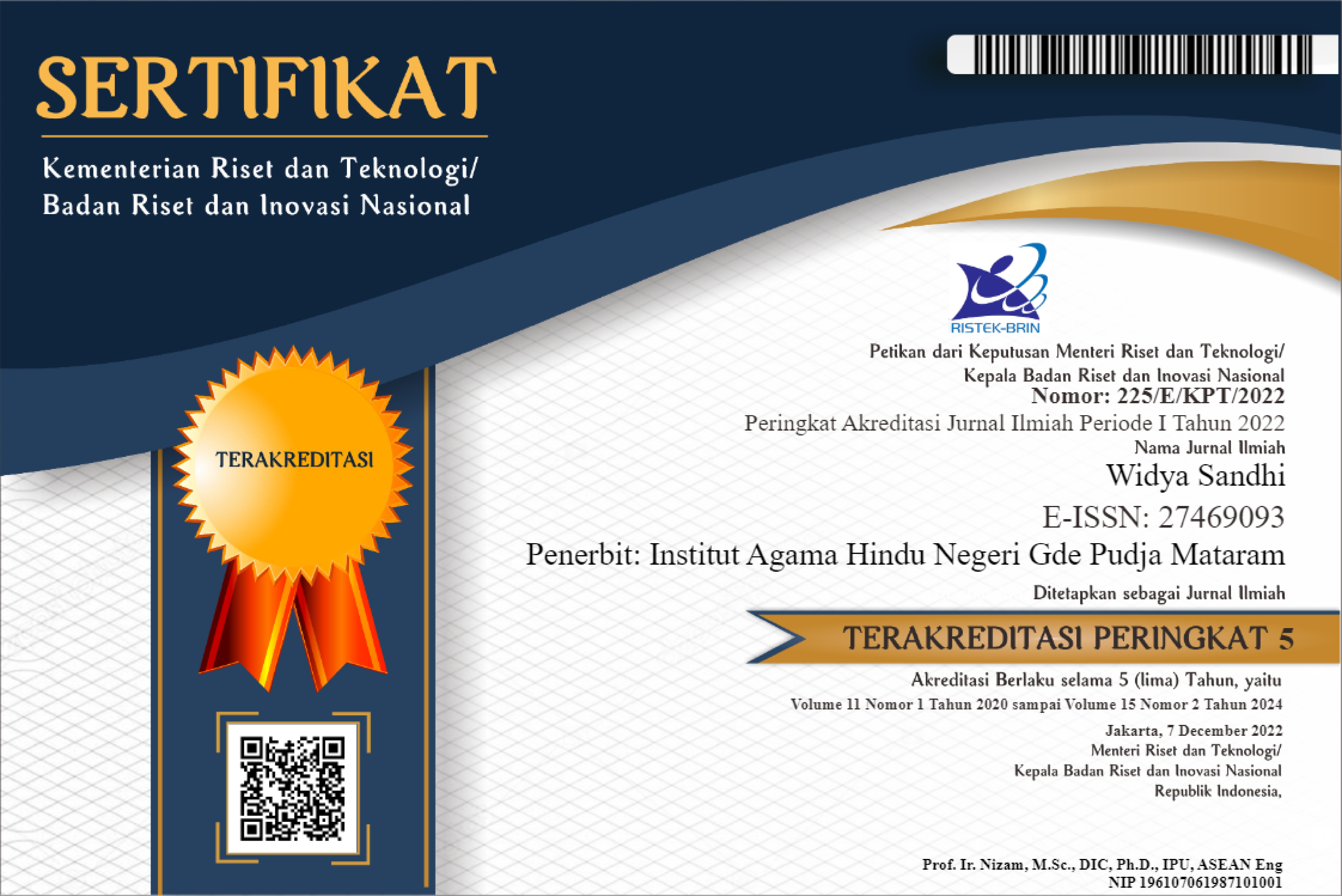UPAKARA PANCA LINGGA AS SYMBOLS OF PANCA DEWATA AT HINDU RITUAL PRACTICES IN LOMBOK
Abstract
This study aims to study the upakara Panca Lingga means of ceremony as a symbol of Panca Dewata in the implementation of Hindu rituals in Lombok. This research was designed in an interpretative qualitative method using a case study model. The results of the study found that the means of ceremony panca lingga is one form of ceremonial facility which is categorized as having a uniqueness that is carried out in the implementation of rituals on the Hindu community in Lombok. The uniqueness that seems in principle is a symbolic to ask for God's grace in its manifestation as the Five Gods, namely Dewa Iswara, Dewa Brahma, Dewa Maha Dewa, Dewa Wisnu and Dewa Çiwa. The Panca Dewata were requested to be present, worshiped and confirmed its place (negtegan) in the ceremony using the ceremony. Upakara Panca Lingga is very sanctified starting from the selection of the material element, which has the right to make it, the procession of its making up to the authority of the devout people, all of which are provisions that indicate the primacy of the ceremony.
References
Griffith Ralph T.H., 1986, The Hymns Of The Rg. Veda, Delhi : Motilal Banarsidass
Mantra I.B. 1993, Tata Susila Hindu Dharma, Jakarta: Hanuman Sakti
Nazir Mohamad, 1999, Metode Penelitian, Jakarta: Ghalia Indonesia
Tim Penyusun, 1999, Buku Pendidikan Agama Hindu Untuk Perguruan Tinggi, Surabaya: Paramita
Pudja, G. 2003. Bhagavad Gītā: Pancamo Veda. Surabaya: Paramita.
Pudja, G dan Sudharta, T. R.2002. Manawa Dharmaçastra (Manu Dharmaçastra atau Weda Smrti Compendium Hukum Hindu. Jakarta: CV Pelita Nursatama Lestari
Soejono, 1999, Metode penelitian Suatu Pemikiran Dan Penerapan, Jakarta: Rineka Cipta
Sudarma, I N. 2000.”Acara Agama Hindu” dalam “Pendalaman Sradha Bagi Generasi Muda Hindu se-Bali. Kintamani: Kumpulan Makalah
Sura I Gede, 1994, Agama Hindu, Sebuah pengantar, Denpasar: Kayumas Agung
Suryabrata Sumadi, 19980, Metode Penelitian, Surabaya: Paramita
Tim Penyusun, 1990, Arjuna Wiwaha Kekawin Miwah Teges Ipuin, Denpasar, Dispendas, Prop. Bali.
Wiana I Ketut, 1993, Bagaimana Umat Hindu menghayati Tuhan, Jakarta: Pustaka Manikgeni
Triguna I.B. Y. 1994. “Pergeseran dalam Pelaksanaan Agama: Menuju Tattwa”dalam Buku Dinamika Masyarakat dan Kebudayaan Bali. Editor: I Gde Pitana. Denpasar : BP.

This work is licensed under a Creative Commons Attribution-NonCommercial-ShareAlike 4.0 International License.
Authors who publish with this journal agree to the following terms:
- Authors retain copyright and grant the journal right of first publication with the work simultaneously licensed under a Creative Commons Attribution-ShareAlike 4.0 International License. that allows others to share the work with an acknowledgment of the work's authorship and initial publication in this journal.
- Authors are able to enter into separate, additional contractual arrangements for the non-exclusive distribution of the journal's published version of the work (e.g., post it to an institutional repository or publish it in a book), with an acknowledgment of its initial publication in this journal.
- Authors are permitted and encouraged to post their work online (e.g., in institutional repositories or on their website) prior to and during the submission process, as it can lead to productive exchanges, as well as earlier and greater citation of published work (See The Effect of Open Access).






.jpg)




